Genealogy Research Resources
Ships Lists: Free Genealogy Resource
August 5, 2012 by ramona
Filed under Articles, Genealogy Research Resources, Latest News, Sharing Genealogy Information
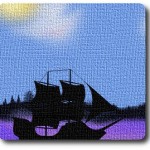 Genealogy beginners looking for immigrant ancestors should head straight over and bookmark The Immigrant Ships Transcribers Guild (ISTG) website.
Genealogy beginners looking for immigrant ancestors should head straight over and bookmark The Immigrant Ships Transcribers Guild (ISTG) website.
The ISTG is a volunteer group that has been working since 1998 to transcribe ships lists on a global scale and publish them on the internet. In the years since its inception, the ISTG website has grown to include volumes of passenger manifests.
The scale of the site may make navigating it a little intimidating to the novice family history hunter. A short tutorial will help make things a little easier.
How to Search the ISTG
Step one:
Locate the search box on the upper left hand corner of the opening page and enter the surname you are researching. This should move you forward to a page with a long list of matches.
Step Two:
On the upper right hand corner of the page, you will find an option for advanced searches…click the option.
The advanced search will give you four text boxes
1. All – will return pages that include all of the terms entered
2. Phrase – will return pages matching the exact phrase
3. Any – will return pages that match any of the terms – in no specific order
4. None – includes other selected items and must be used in tandem with other fields
For example, entering “Alexander McCallum” into the “All” field returns ships named Alexander as well as passengers surnamed Alexander and McCallum.
The same search entered in the “Phrase” field returns only passengers named Alexander McCallum.
In the Any field these search terms return the same results as entering into the “All” field. It is good to use the “None” field in tandem as you can enter terms you do not want matched in order to narrow your search.
Once you are comfortable using the search function you will be free to search some of this sites great free resources from Jacobite rebellion ships to New York arrivals.
One great feature of this site that you will not want to miss is the ISTG compass, which is a tool to simplify your searches by breaking down resources into consumable information bites.
The ISTG is another site that relies heavily on volunteer transcribers, if you would like to help check out their Guild Application for more information.
Make sure you are prepared for your visit to The Immigrant Ships Transcribers Guild with Genealogy Beginners Family Tree Starter Kit, available with your 30-day free membership.
Research Americas Earliest Immigrants FREE
July 30, 2012 by ramona
Filed under Articles, Genealogy Research Resources, Latest News, Sharing Genealogy Information
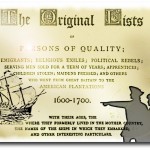 Family Tree fanatics wishing to research the earliest immigrants to the Americas are in for a real treat with this fantastic book published in 1874 and titled The Original Lists.
Family Tree fanatics wishing to research the earliest immigrants to the Americas are in for a real treat with this fantastic book published in 1874 and titled The Original Lists.
The book will be of great interest to any family history seekers whose family came to the Americas during 1600-1700.
Its contents are comprised of the original lists of:
- Persons of quality
- Emigrants
- Religious exiles
- Political rebels
- Serving men sold for a term of years
- Apprentices
- Children stolen
- Maidens pressed; and others who went from Great Britain to the American Plantations, 1600-1700
It is exciting to note that within the pages of this fantastic resource is a list of early immigrant passengers that came over on the Mayflower (1620), The Fortune (1621), The Anne and Little James(1623).
Along with this bounty of genealogical booty, the book lists the ages of individuals, the ships they embarked on and various other interesting details such as the following:
“The bill of mortality of the said rebells that dyed since they were reced on board and were thrown overboard out of the said ship are these uiz. December the Sixteenth Thomas Venner, Seventeenth W* Guppy, Eighteenth John Willis, Nineteenth Edward Venn, the same day Philip Cox one and Twentieth Robert Vawter, Five and Twentieth Wm Greenway, January the first Peter Bird, Witnessed by the commander, March and officers’ of the said ship this Eigth day of January 1685.”
John May
John Penn
John Maddison
Gabriel Whithorn
Malcum Fraser
One very interesting chapter is “Entries relating to America taken from the Indexes to the Patent Rolls, commencing 4 James I 1606 and ending 14 William III 1702.” The entries in this section are very intriguing and include entries such as:
“Grant of Incorporation, by the name of the treasurer and Company of Adventurers and Planters in the city of London and Bristol, For the Colony and Plantation in Newfoundland.”
Taken from manuscripts held in the State Department; Her Majesty’s Public Record Office, England, this incredible resource is filled from cover to cover with fascinating histories of the earliest pioneers to the Americas.
Before you start flipping through the pages, remember to download your Family Tree Charts and Research Tracking forms available with your 30- Day free trial to Genealogy Beginner.
Read The Original Lists at Internet Archives
Find a Grave: Free Family Tree Resource
July 5, 2012 by ramona
Filed under Articles, Genealogy Research Resources, General Tips, Latest News, Sharing Genealogy Information
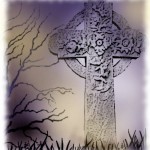 Find a Grave is a FREE genealogical resource that every genealogy beginner should visit and bookmark today.
Find a Grave is a FREE genealogical resource that every genealogy beginner should visit and bookmark today.
Founded in 1995 by Jim Tipton, a self-proclaimed nerd with the odd hobby of searching out and visiting the grave sites of the famous; Tipton’s goal in the creation of the site was to share his interest with like-minded others.
It was not long before he came to the realization that his hobby had great historical and genealogical significance.
What Does Find a Grave Contain?
Filled with memorials this virtual cemetery has listings for:
- North America (by province and state)
- South America
- Europe
- Asia
- Australia and Oceana
- Africa
Not to be forgotten is the “Famous Graves” section that has a comprehensive search field that allows for numerous search types.
It also has some fun categories such as:
Yearly Necrologies: listings of individuals who died during specific times
Posthumous Reunions: a page that lists movies and TV shows with cast members who have passed away. For example when I clicked on the TV show Star Trek, it listed 46 cast members (both guest starts and original crew). For each listing, it gave the date and place of birth and death, a biography that contained many details, cause of death, place of burial and special details.
Interesting Epitaphs: This category is self explanatory and indeed does contain some very interesting epitaphs.
Is it Worth My Time?
The best way to tackle this question is by giving it a test run. For this purpose, I will use three of my ancestors, one from the US, one from Canada and one from Scotland using the broadest search category…surname search.
- U. S. – Undseth: This search did not return any direct line ancestors, however there were a few cousins listed.
- Canada – McCallum: This search found several of my ancestors graves listed in three provinces.
- Scotland – Sinclair: This Search was the most successful and returned numerous family lines from the Orkney Islands.
Find a Grave is most definitely worth your time. In fact, you could easily spend hours and hours searching through the site for burial records to flesh out your family history.
How do I Join?
Joining is easy; simply fill out the online registration and you can immediately begin searching for your ancestors.
Find a Grave is a true genealogy treasure that allows you to not only search for your ancestors but also to contribute to the already huge database. Before you get started, be sure to download your complementary Cemetery Visit Tracking Form available with your free 30-day trail membership to Genealogy Beginner.
Free Genealogy Translation Services
July 2, 2012 by ramona
Filed under Articles, Genealogy Research Resources, Latest News, Sharing Genealogy Information
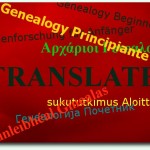 If your ancestors are from Europe, Asia, Russia, South America or another non-English speaking region; you are probably among countless other family tree researchers who will eventually need help translating your genealogy documents.
If your ancestors are from Europe, Asia, Russia, South America or another non-English speaking region; you are probably among countless other family tree researchers who will eventually need help translating your genealogy documents.
Although free online translators have become an abundant resource on the net, when it comes to archaic words, idioms or technical terms they may fall short of expectation.
Live translation services can be costly however; there are some wonderful folks out there who offer genealogy translation services free of charge.
- Linguanaut. Is a site with access to 150 translators, their goal is to connect people in need of a translation with a volunteer translator. To get started just click on Free Translation then choose your language and they will match you up with a translator. (Short non-commercial translations only).
- Freelang: is a fantastic resource with hundreds of volunteers that offers free “short” translations for non-commercial reasons.
To use their service all you need to do is:
- select a language
- select a translator
- fill out their contact form
Your translator will contact you via email with your translation.
- Cucumis: is based on the exchange of services for the benefit of all. This service works on a point system, for example; you can earn points by translating something for another member. However, even if you only speak one language you can still earn points simply by signing up
- WikiTranslation. This site is the simplest to use. All you need to do is fill out their translation request form and someone should get back to you via email.
Of course, there are other language specific services available as well and a quick Google search should give you a list of sites in no time. Happy ancestor hunting.
The Lost Irish: FREE Searchable Database
June 30, 2012 by ramona
Filed under Articles, Genealogy Research Resources, Latest News, Sharing Genealogy Information
 During the nineteenth and early twentieth century, Irish immigrants flocked to North America in droves. Leaving their homeland, due to poverty, political upheaval and famine; or simply to begin anew, they came in hopes of finding a better life.
During the nineteenth and early twentieth century, Irish immigrants flocked to North America in droves. Leaving their homeland, due to poverty, political upheaval and famine; or simply to begin anew, they came in hopes of finding a better life.
Leaving family and friends behind, their only mode of communication with loved ones was by letter. However, the international postal system was just developing and many immigrants lost touch with the folk back home. As a result, many new immigrants were lost to their relatives who remained in Ireland.
Missing Friends
October 1831 marked the birth of a new feature in the Boston Pilot newspaper when an advertisement seeking a Patrick McDermott and his family was published. This advertisement began what later became known as the “Missing Friends” column. The column was an instant success, increasing the newspapers circulation both at home and on an international scale.
A Family Tree Resource
Lasting an amazing ninety years the column ran from 1831 to 1921 and helped countless people find those they had lost. For family history buffs this translates into an amazing FREE resource for finding Irish ancestors. This genealogical treasure contains 40,268 records with text for every advertisement that was placed in the paper.
While the information included varies, it is possible to find some informative facts such as:
- county and parish of birth
- date they left Ireland
- expected port of arrival
- occupation
Using the Database
Although the database has a simple search, the advanced search function allows a great deal of flexibility.
MISSING PERSON’S INFORMATION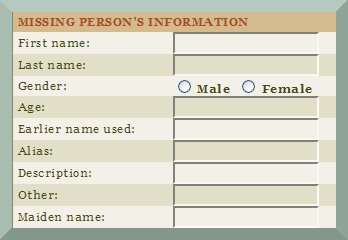 |
Using this search box, I entered the name Patrick O’Brian that returned 452 results. The information returned included:Home County: CorkTownland: Ballydunigan Nr. Bear HavenDeparture date: 1859Port of Departure: England, Liverpool Port of Arrival: MA, Boston |
| Additionally there was a description of the ad placed for him:Any Info Alive Or Dead. Other: Last May (05/65) He Resided W/His Si = Margaret O Brien For About A Mo.; He + His Br. = Denis Started To Mi, Lake Superior + Lived W/Fa + Mo For 6 Yrs; He Got M. About 2 Yrs Ago; Came To Visit His Mo. A Yr Ago Last 4-Jul To Mn Coppermines, Antaugon Co. | |
SEEKING PERSON’S INFORMATION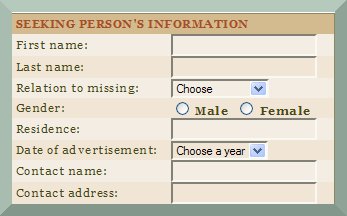 |
The above search also returned the data for the person seeking Mr. O’Brien.Name: Catherine O BrienRelation to missing: MotherGender: FemaleResidence: OH, Youngstown, Mahoning CountyDate of advertisement:08-25-1866 |
POINT OF ORIGIN INFORMATION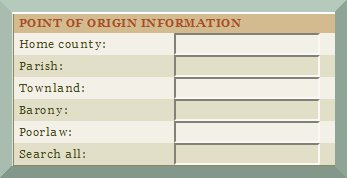 |
The advanced search also lets you search for a person by point of origin.For this search, I used Dublin as my point of origin, which only returned five results. |
WORK HISTORY |
If you know your ancestors trade, searching by occupation can give you a wide field of reference.I tried looking for:
|
LOCATION AFTER ARRIVAL |
As many American immigrants first came to North America through Canadian ports, I tried a search for Nova Scotia (A common port of entry for many U.S. immigrants). This search returned 26 results. Under the results was listed Patrick O Donnell, a Shoemaker who after arriving in Nova Scotia travelled to Mo, St. Louis (1859) and ended up in LA, New Orleans |
| The description for Mr. O Donnell reads.M. in Nova Scotia, Halifax (1857); His Wi. = Bridget O Donnell (Borve) in Canada, Quebec Is Anxious To Hear Some Tidings Of Him. Other: Last Heard He Worked at His Trade in LA, New Orleans; At The Time He Left Ns, Halifax He Had A Npw. = John A. Hearns Studying at The Seminary Of Carondolet Nr. Mo, St. Louis | |
TRAVEL INFORMATION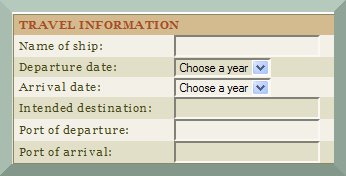 |
Searching by travel information allows you to simply select a year or the intended destination; very handy for researchers who are working with limited information. |
Key Word Search |
The last search field allows you to do a search of the entire database. You can search by name or by keyword. This is very handy should you have an ancestor with an alias or nickname.For example, a search under “Bessy” (short for Elizabeth) returned 55 results including the information for Elizabeth Daily AKA Bessy Daily. |
If you are ready to start searching for your missing ancestor, Boston College searchable database can be found at http://infowanted.bc.edu/.
Before you head off remember to get your Genealogy Beginner family tree charts and research tracking forms available with your 30-day free trial.
Genealogy: Getting to Know Your Ancestors
June 14, 2012 by ramona
Filed under Archives, Family History, Genealogy groups, societies and organizations, Latest News
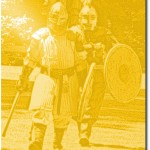 The Merriam Webster Dictionary gives a definition of genealogy as:
The Merriam Webster Dictionary gives a definition of genealogy as:
- an account of the descent of a person, family, or group from an ancestor or from older forms
- the study of family pedigrees
Strictly speaking, this is true; it is certainly a good definition of the process and an accurate descriptor of the intent with which genealogy is first approached. However, to those of us who have spent any length of time on this addictive hobby, the study of our ancestors begins to take on new meaning.
It is not long after family tree research begins that the dry definitions become inadequate. As we work our way through record after record, learning piecemeal the details of our ancestors lives we begin to feel we are getting to know them as individuals.
For some, the genealogical aspects of family history research are not enough. We want to get to know our forefathers on a deeper level. Become more familiar with their day-to-day lives.
If you count yourself among those wishing for a deeper understanding of your generations past, there are a number of activities you can participate in; activities that will allow you to experience your family history in a very real way.
Recreationists
Pick almost any period in history and you will find a group of people actively recreating the era. Living history groups include the activities, dress and tools of the eras they portray to give participants the sense of stepping back through time. Recreationists are not re-enactors; they are not scripted nor are they involved in recreating specific events. Member’s interests can include clothing styles, pastimes, cookery and artisanship, everything that would help create a feeling of every day life in bygone days. It is not at all surprising that among their ranks you find many genealogists and family historians.
Living History Groups
From late 20th century groups like “The 20th Century Revisited” A UK based group recreating scenes and events from various parts of the later 20th Century including WW2 resistance, and 1970 British Army of the Rhine (BAOR) or “Paper Dolls” An international group made up of female members who portray military and civilian life during World War Two. From hometown sweethearts, Women’s Land Army, French Resistance, American Red Cross, Women’s Army Corps. These groups offer an opportunity to learn what it was like for ancestors who lived during the great wars; both on and off the battlefield.
If you are more interested in the events of the 19th century The Living History Society of Minnesota members can attend workshops and participate in activities designed to increase their knowledge of mid 19th century life. For those whose Gr,Gr,Gr, Grandfathers heeded the familiar call of “Go West young Man” the Mojave Muleskinners have several branches across the US, Canada and the UK where you can immerse yourself and learn about life in the old west.
If you can trace your family tree to medieval times, a living history group from the Middle Ages may be more suiting. The Society for Creative Anachronism (SCA) is an international organization with over 30,000 members residing in countries around the world. One of the best things about this group is that you will find a mix of cultures from Viking to Italian to Middle Eastern. Members attend events such as tournaments, royal courts, feasts, dancing, various classes, workshops and more. The SCA is a group that lets you explore all of the European lines in your family tree.
If you want to know more about how living history groups can help enrich your genealogy and family history or how to find a group near you, just post a question to the Genealogy in General board on the Genealogy Beginner forums.
Black Sheep Ancestors
May 11, 2012 by ramona
Filed under Articles, Genealogy Research Resources, Latest News, Sharing Genealogy Information
 Pirates, Outlaws and Ne’er do wells; it would be uncommon to research any family tree without finding at least one skeleton in the closet.
Pirates, Outlaws and Ne’er do wells; it would be uncommon to research any family tree without finding at least one skeleton in the closet.
Ancestors with a criminal record can range from unfortunate debtors who paid a price for being poor to thieves and pickpockets or even those executed for murder. Although none of us wants to find we descended from a cold-blooded killer, having a rogue in the family tree does add a little excitement.
Throughout history there have been criminals and alongside them court systems and institutions for dealing with them. With prisons and courts come the records they generate and those records are a wonderful resource for genealogists and family historians looking for a missing ancestor.
Information found in court and prison records can include the accused or inmate’s next of kin, name and age. Whether or not they could read, their trade, the reason they were in trouble and the sentence they received for their crime.
Finding Criminals Past
Blacksheep Ancestors is a free genealogy site filled with prison lists and court records that encompass Great Britain, Canada and the US.
One fantastic and free searchable list is The Proceedings of the Old Bailey, 1674-1913, which has a fully searchable database that contains 197,745 criminal trials from London’s central criminal court.
The site also has links to the biographies of petty and master criminals alike where you can read the stories about:
- Catherine Hayes, who in 1725 conspired with her lovers to kill her husband and was tried, convicted and executed for her crime.
- The Fourth Earl Shirley, Laurence Ferrers, who was the last peer of the realm convicted as a common criminal and hanged
- Eliza Fenning, a young cook who was found guilty of the attempted murder of her employers by poisoning their food. Up until the moment Eliza was put to death, she claimed her innocence.
Whether you have an ancestor who was a minor miscreant or someone with an infamous criminal past, Blacksheep Ancestors is a fascinating genealogy website dedicated to helping you trace the romantic rogues and villainous scoundrels in your ancestral line. Share your Black sheep story on Genealogy in General.
Global Adoptee Genealogy Project
May 6, 2012 by ramona
Filed under Articles, Genealogy groups, societies and organizations, Genealogy Research Resources, Latest News
 The world of genealogy is ever evolving; every day there is word of a new group or project on the horizon that promises to enrich the global genealogy community. As a genealogist who is also an adoptee, I am always excited to hear about groups like The Mixed Roots Foundation and their Global Adoptee Genealogy Project.
The world of genealogy is ever evolving; every day there is word of a new group or project on the horizon that promises to enrich the global genealogy community. As a genealogist who is also an adoptee, I am always excited to hear about groups like The Mixed Roots Foundation and their Global Adoptee Genealogy Project.
Today in the United States 6 in every 10 people are touched by adoption.
The Mixed Roots Foundation is the first ever-registered charity set up to aid adoptees in finding their genetic roots. The charity, whose board members are all adoptees, has made it their mission to support those individuals adopted and fostered, by raising awareness of the adoption experience.
Among the goals of the Mixed Roots Foundation is the mission to provide more post adoption resources for adoptees and their families. This includes a project geared to help adoptees trace their family tree. The project that directly addresses this is the Global Adoptee Genealogy Project (GAGP).
Global Adoptee Genealogy Project
The Global Adoptee genealogy Project is looking to answer the questions.
“Who are you? What are you? and Where are you?”
The aim of this project is to aid adoptees in learning more about their genetic and cultural roots. In an effort to achieve this goal they are partnering with the DNA testing facilities 23andME and Family Tree DNA. The foundation will also be recruiting adoptees and their families for participation in the project and through the Filling in the Gap Fund, they will be providing funds to offset the costs of DNA testing for adoptees in need of financial assistance.
Bennett Greenspan, president of Family Tree DNA has this to say about the project.
“As an evangelist for genetic genealogy, I encounter adoptees all the time. They want this and, more importantly, they need GAGP. Adoptees have a thirst to know who they are, what they are and why they were adopted. DNA testing offers potential answers to two of those three questions. We hope that as the database grows, more and more matches will be made.”
One of the project supporters, The Evan B. Donaldson Adoption Institute, (a national leader in adoption-related research, education and advocacy) will be playing a large role in efforts to reach the adoption community and get the word out about GAGP.
Executive Director, Adam Pertman states, “The Mixed Roots Foundation is doing something genuinely important, with real scope and vision, and with the promise of impacting many, many lives in a positive way,” Peterman also says, “We know, from both research and experience, that access to one’s own information is a vital part of life, including shaping a positive identity. This project will go a long way toward giving adopted people the tools and knowledge to start putting together the pieces of their own puzzles. It’s purely wonderful.”
The project launch is set for Monday May 21, 2012 at the Punch Line Comedy Club in San Francisco, CA. A portion of proceeds from this fundraiser will go to the Filling in the GAGP Fund. Additionally DNA testing partners have donated testing kits as raffle prizes.
For more information about Global Adoptee Genealogy Project and The Mixed Roots Foundation, join us on the Genealogy in General forum.
Find Your Ancestors in Almanacs
April 1, 2012 by ramona
Filed under Articles, Genealogy Research Resources, Latest News, Sharing Genealogy Information
 Almanacs can be a great resource for genealogists and family historians. Along with weather predictions, advice for farmers and statistical information almanacs can contain tit bits of information about your ancestors that are not found in vital events documents or census. Additionally almanacs can give wonderful ephemeral information to round out your family history story and fill in your family template. Gutenberg printed the very first almanac in 1457 in Mentz, Germany and their use spread to almost every country by the 1600s. By the 1800s, it was possible to find yearly almanacs for nearly every county in Great Britain.
Almanacs can be a great resource for genealogists and family historians. Along with weather predictions, advice for farmers and statistical information almanacs can contain tit bits of information about your ancestors that are not found in vital events documents or census. Additionally almanacs can give wonderful ephemeral information to round out your family history story and fill in your family template. Gutenberg printed the very first almanac in 1457 in Mentz, Germany and their use spread to almost every country by the 1600s. By the 1800s, it was possible to find yearly almanacs for nearly every county in Great Britain.
The best way to demonstrate what a great resource an almanac can be is by looking in one for information. For this purpose “Peace’s Orkney Almanac and County Directory, 1886” gives us a great example of genealogical and family history information that.
The Family History Element
Within the front and back pages of the almanac, there is a wide range of advertisements that present a window into your ancestor’s daily lives.
From these advertising pages, we get a glimpse at the fashions of the times, modes of travel, an idea of how they may have approached emigrating to a new land and even some insight into daily chores.

Almanacs and Genealogy
An almanac contains a wealth of information in the trades sections. From listings of “Inspectors of the Poor” to a list of “Registrars of Births, Marriages and Deaths” that can be very helpful in pinpointing those questionable dates. Looking at this entry, we can see the timelines given to register any vital events.

Almanacs can also be used to help you find resources for records. Peaces Orkney and Shetland Almanac names all of the churches, clergy, schools and teachers in the county. It also gives the names of newspapers that were published at the time along with groups, society’s guilds and clubs, which are all fantastic sources of information for family tree research.
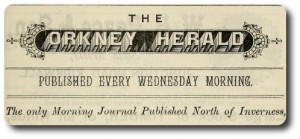
Additionally, it is common for almanacs to break up the directory listings by parish where you may find information that is more specific to your ancestor. Flipping to the directory for Sanday we find out that Peter Sinclair is listed as a member of the Parochial Board as well as a member of the School Board, which suggests he was an active member of his community. Not information found in a census, in fact almanacs are probably the number one place to look if you are searching for clues about your ancestors between census years.
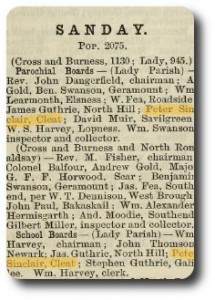
In this particular issue, we get lucky, as there is register of voters that not only lists the men but also gives a list of female municipal electors that predates women being given the right to vote in Great Britain. Looking at an almanac for genealogy can not only help locate ancestors and resources, it can also teach a few things that we may not learn from history books; such as areas where reform was more progressive. The pictures and stories of an almanac are one of those often forgotten information sources that can paint a surprisingly vivid picture of your family tree.
Image Credits: Ramona Hartley, Peaces Orkney Almanac and County Directory
Source: Internet Archives, National Library of Scotland
Rights: National Library of Scotland holds full rights in this digital resource and agrees to license the resource under the Creative Commons License: Attribution-Noncommercial-Share Alike 2.5 UK: Scotland.
Creative Commons license: Attribution-Noncommercial-Share Alike 2.5 UK: Scotland
Licenseurl: http://creativecommons.org/licenses/by-nc-sa/2.5/scotland/
Genealogy & Newspapers: Obituaries
March 25, 2012 by ramona
Filed under Articles, Genealogy Research Resources, Latest News, Sharing Genealogy Information
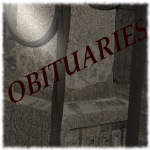
One single record may tell you more about your ancestor than a death, marriage and birth certificate combined and that is their obituary. Obituaries can provide information about your ancestor that cannot be found in civil and church records and that makes them one of the best sources of genealogical information available. Before death certificates were even required obituaries had already long existed.
The Value of Obituaries to Genealogical Research
Even when you have already obtained all of the official records for your ancestors, an obituary can help fill in the gaps between years. Obituaries frequently impart valuable information about events that happened in the years between birth, marriage, the census returns and death.
For example, an obituary can identify children you may have missed. Often when we look at a timeline of our ancestor’s childbearing year’s we see that births occur in a pattern. Such is the case with my ancestors Peter Sinclair and Catherine Calder.
Children of Peter Sinclair and Catherine Calder m. 1854:
- James Sinclair b. 1855
- Isabella (Bella) Sinclair b.1857
- Catherine Drever Sinclair b. 1859
- Richard Sinclair b.1861
- William Sinclair b.1862
- Jean Sinclair b.1867
- Peter Sinclair b.1870
- Robert Sinclair b.1874
You can see by the example that from their first child to their fifth child there was two years between births. Then the pattern breaks with a five-year gap between the fifth and sixth child, a three-year gap between the sixth and seventh child and a four-year gap between the last two.
Gaps like this indicate the possible loss of a child. If you find gaps such as this that lie between census years and no record of birth or death has been found, an obituary is the logical place to look.
Your Ancestors Obituary
Here is a quick look at some of the other information that can be found in an obituary.
- Dates of birth, marriage and death
- Place of birth, marriage and death
- Name of parents and grandparents
- Number of children and grandchildren
- Names of children and grandchildren
- Residences and Occupations
- Memberships to clubs or societies
- Religion and church attended
- Military Service information
- Cause of death
Where to Find Obituaries for Your Family Tree
When you think of obituaries, the primary resource that comes to mind is newspapers. That is certainly a logical conclusion, the next questions are where to find the newspapers and if you are researching from a distance how to access them.
A great source for this information is online obituary indexes. Obituary indexes such as the Library of congress’s “Chronicling of America” provides searchable, free, online access to a huge database of newspapers from 1836 – 1922. If the newspaper you are looking for were not accessible online your next strategy would be to locate an obituary look-up or mailing list.
Although newspapers are recognizably the main source of obituaries, they are only half the story. Obituaries and obituary indexes can also be found in published journals, such as the “Obituaries Index Prior to 1800 by Sir William Musgrave” an index to the obituaries of “memorable persons” of England, Scotland and Ireland. This publication and others like it hold a treasure trove of ancestral information that may point out obituaries published in books, university papers, magazines and memoirs. All great sources that get you closer to adding another generation to your family template.
If you have any tips to share on researching obituaries or any questions about this wonderful source of ancestral information, join us on the Genealogy in General forum.
Image Credit: Ramona Hartley
